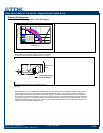
Data Sheet: Belleta
®
iEA Series –Single Output Eighth Brick
©2004 TDK Innoveta® Inc.
iEAFullDatasheet 032707 3/29/2007 Revision 2.0
℡
(877) 498
-
0099
37/41
Heat transfer by convection can be
enhanced by increasing the airflow rate that
the power module experiences. The
maximum output current of the power
module is a function of ambient temperature
(T
AMB
) and airflow rate as shown in the
thermal performance figures on the thermal
performance page for the power module of
interest. The curves in the figures are
shown for natural convection through 2 m/s
(400 ft/min). The data for the natural
convection condition has been collected at
0.3 m/s (60 ft/min) of airflow, which is the
typical airflow generated by other heat
dissipating components in many of the
systems that these types of modules are
used in. In the final system configurations,
the airflow rate for the natural convection
condition can vary due to temperature
gradients from other heat dissipating
components.
Operating Information:
Over-Current Protection: The power
modules have current limit protection to
protect the module during output overload
and short circuit conditions. During overload
conditions, the power modules may protect
themselves by entering a hiccup current limit
mode. The modules will operate normally
once the output current returns to the
specified operating range. There is a typical
delay of 30mS from the time an overload
condition appears at the module output until
the hiccup mode will occur.
Output Over-Voltage Protection: The
power modules have a control circuit,
independent of the primary control loop that
reduces the risk of over voltage appearing at
the output of the power module during a
fault condition. If there is a fault in the
primary regulation loop, the over voltage
protection circuitry will cause the power
module to enter a hiccup over-voltage mode
once it detects that the output voltage has
reached the level indicated on the Electrical
Data section for the power module of
interest. When the condition causing the
over-voltage is corrected, the module will
operate normally.
An optional latching over-voltage protection
is available. On modules with this feature,
the power module will shut down once it
detects that the output voltage has reached
the level indicated on the Electrical Data
section for the power module of interest.
The module remains off unless the input
voltage is recycled.
Thermal Protection: When the power
modules exceed the maximum operating
temperature, the modules may turn off to
safeguard the power unit against thermal
damage. The module will auto restart as the
unit is cooled below the over temperature
threshold. On modules with the latching
over-voltage protection feature, the unit may
latch off during a severe over temperature
condition; the module remains off unless the
input voltage is recycled.
Remote On/Off: - The power modules have
an internal remote on/off circuit. The user
must supply an open-collector or compatible
switch between the Vin(-) pin and the on/off
pin. The maximum voltage generated by
the power module at the on/off terminal is
15V. The maximum allowable leakage
current of the switch is 50uA. The switch
must be capable of maintaining a low signal
Von/off < 1.2V while sinking 1mA.
The standard on/off logic is positive logic.
The power module will turn on if terminal 2 is
left open and will be off if terminal 2 is
connected to terminal 3. If the positive logic
circuit is not being used, terminal 2 should
be left open.
An optional negative logic is available. The
power module will turn on if terminal 2 is
connected to terminal 3, and it will be off if
terminal 2 is left open. If the negative logic
feature is not being used, terminal 2 should
be shorted to terminal 3.


















